IBDP Online Test Series By iitianacademy
Comprehensive Test Preparatory package targeted towards IBDP
Question
The scanning electron micrograph shows a biofilm on a metal surface from an industrial water system.
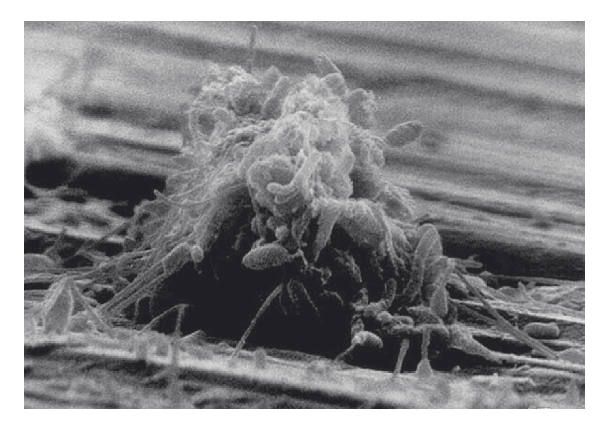
[Source: Biofilms: Survival Mechanisms of Clinically Relevant Microorganisms, Rodney M. Donlan, J. William Costerton, Clinical Microbiology Reviews, 2002, 15 (2), pp. 167–193. Reproduced with permission from American Society for Microbiology]
Outline the emergent properties of biofilms.
State a positive application of biofilms.
Suggest two problems that could be caused by the presence of biofilms in water systems.
Answer/Explanation
Markscheme
a. properties not present in individuals but present/develop only in the aggregate
OWTTE
b. develop structure/architecture/scaffolding
OR
develop an «extracellular» matrix/EPS
c. signaling/communication
d. migration/movement
e. resistant to antimicrobial agents
f. cooperates through quorum sensing
[Max 3 Marks]
a. sewage/waste water treatment/trickle filter beds
b. «bio»remediation of contaminated soil/water
c. metal extraction from ore deposits/microbial leaching
Accept other valid positive application
eg: decay/breakdown contaminants, such as petroleum
[Max 1 Mark]
a. contamination/pollution «of water system»
OR
«microbial growth of biofilm» causes disease through water systems
b. difficult to eliminate «from water systems»
c. fouling/clogging of water pipes
d. corrosion of water pipes
OWTTE
[Max 2 Marks]
Question
Compounds containing the cyanide group (CN) are used to help extract gold from gold-containing rocks called ore. The process results in heaps of rocks that are contaminated with cyanide, a toxin that can inhibit cellular respiration. The bacterium Pseudomonas fluorescens degrades cyanide to ammonia (NH3 ), which is less toxic.
![]()
In an effort to explore the conditions that lead to maximum degradation of cyanide, researchers sprayed different samples of cyanide-processed ore with one of three solutions:
• a sterile solution
• a solution containing a culture of P. fluorescens
• a solution containing a culture of P. fluorescens and sucrose.
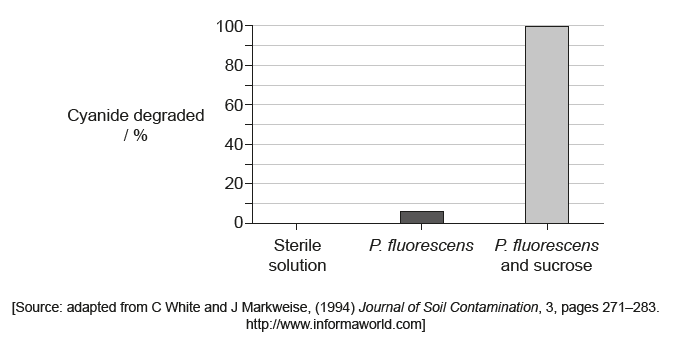
Outline the evidence that P. fluorescens can degrade the cyanide.
Suggest how the addition of sucrose promotes the degradation of cyanide.
With respect to the degradation of cyanide by P. fluorescens, explain what is meant by bioremediation.
Answer/Explanation
Markscheme
a. in sterile solution/control there is no degradation of cyanide but there is in the solutions with P. fluorescens
OWTTE
b. in solution containing P. fluorescens and sucrose degradation of cyanide higher than without sucrose
c. control with sucrose «only» missing to establish causality OWTTE
«organic» carbon source «necessary for the reaction to degrade cyanide»
OR
sucrose provides the energy source
a. bioremediation is the use of organisms to degrade pollution/toxins in the environment
b. P. fluorescens necessary to degrade cyanide which is toxic to the environment OWTTE
c. often involves supplementing with nutrients/carbon source/aeration
Question
The micrograph below shows an example of a biofilm including Staphylococcus aureus.
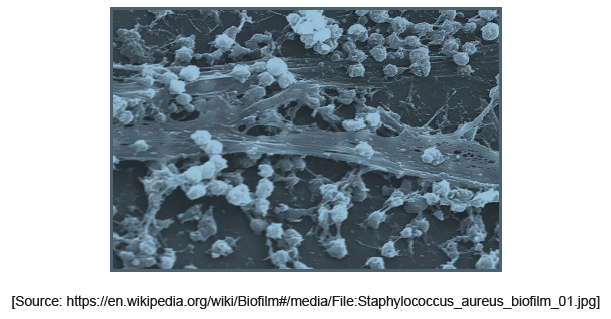
Biofilms can be formed in many different environments.
State one example of an environment where biofilms can be formed.
Discuss the emergent properties of biofilms.
Answer/Explanation
Markscheme
cooling- or heating-water systems / rocks at the bottom of a river / teeth «of most animals» / prepared on sewage treatment plants / boat hulls / medical catheters
Accept other verified examples
a. have «new» properties that are not present in the individual microorganisms
b. organisms form a matrix «EPS» / biofilms have a complex architecture
c. increased resistance to antibiotics/treatments
OR
bioluminescence
d. biofilms can be formed by different types of micro organisms that interact/cooperate
e. quorum sensing
OR
high population/cell density determines expression of genes
Question
Explain the formation of biofilms and the problems associated with their formation.
Answer/Explanation
Markscheme
Formation
a. biofilm is a group of microorganisms embedded in a «exopolysaccharide/EPS» matrix
b. microorganisms adhere on a surface/to each other
c. cells are able to communicate/cooperate via quorum sensing
OR
secrete molecules that facilitate the aggregate adhering to the surface
OR
facilitate individual cells sticking together/OWTTE
d. phenotypic shift in behaviour
OR
emergent properties appear
OR
differential regulation of genes
Problems
e. «formation of biofilms» in the body facilitates infections/OWTTE
Accept any verifiable health problem caused by biofilms, e.g. dental plaque causing caries, lung infection in cystic fibrosis patients, etc.
f. clogging/corrosion of pipes in water systems
g. transfer of microorganisms in ballast water
h. contamination of surfaces in food production
i. highly resistant to antimicrobial agents/antibiotics
j. EPS provides a physical barrier to the entry of the antibiotic «into the colony»
Award [5 max] if only problems are mentioned.
Question
The dye Reactive Black 5 (RB5) is widely used for dyeing in textile industries. Removal of the dye from factory waste-water is important not only for aesthetic reasons but also because the dye can lead to mutations that may lead to cancer. Paenibacillus is a bacterium that can metabolize the dye.
Suggest one way in which organisms such as Paenibacillus metabolize toxic substances.
The decontamination system for the removal of the dye uses a surface to which Paenibacillus can attach. Suggest one advantage of providing a surface for attachment.
Outline another named example of a microorganism used in bioremediation.
Answer/Explanation
Markscheme
Uses it as an energy source/carbon source/electron acceptor
Do not accept “metabolizes” it.
To allow for the formation of a biofilm
OR
Does not get washed away/can be re-used
Increases surface area which increases contact between bacteria and dye
Question
Describe the consequences of releasing raw sewage into rivers.
Answer/Explanation
Markscheme
a. pathogens/toxins may be released/contaminate drinking water;
b. (saprotrophic) bacteria live off sewage;
c. decrease dissolved oxygen/DO / increase the oxygen demand/BOD;
d. animals/other (aerobic) organisms may die;
e. decomposition causes increase in ammonia/nitrates/phosphates/CO2;
f. high levels of nitrate/phosphate can stimulate algal growth/blooms / eutrophication;
g. block light for other algae/plants below;
h. which die and decompose, releasing more nutrients;
i. promote more algal growth;
Question
State one example of a bacterium that forms aggregates.
Outline the process of nitrogen fixation by a named free-living bacterium.
The image shows part of a sewage treatment plant.
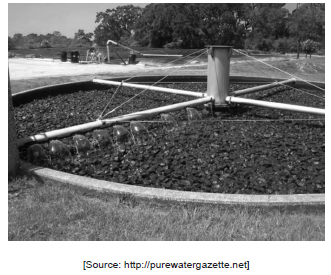
Outline the role of bacteria in trickling filter bed treatment of sewage.
Answer/Explanation
Markscheme
Pseudomonas aeruginosa / Vibrio fischeri
Accept other correct answers.
a. (atmospheric) nitrogen is converted to ammonia;
b. by Azotobacter;
Do not accept Rhizobium.
a. (saprotrophic) bacteria/biofilm fix on the surface of the rocks/material in the trickling filter;
b. bacteria decompose the sewage/organic matter as it runs over the filter bed;
c. bacteria break down organic matter aerobically;
d. the rocks increase the surface area for the decomposition of organic matter;
e. filter bed can treat high amounts of sewage quickly;
Question
Waste water from industrial processes contains a range of toxic substances that are harmful to the environment. These toxins include sulphide (S2–) and metal ions such as chromium (Cr3+). Microorganisms such as Brachymonas denitrificans that carry out denitrification of waste water, may be inhibited by these toxins. The effects of different concentrations of toxins on the rates of denitrification by B. denitrificans and a group of denitrifying bacteria named BPT3 are shown in the graph below.
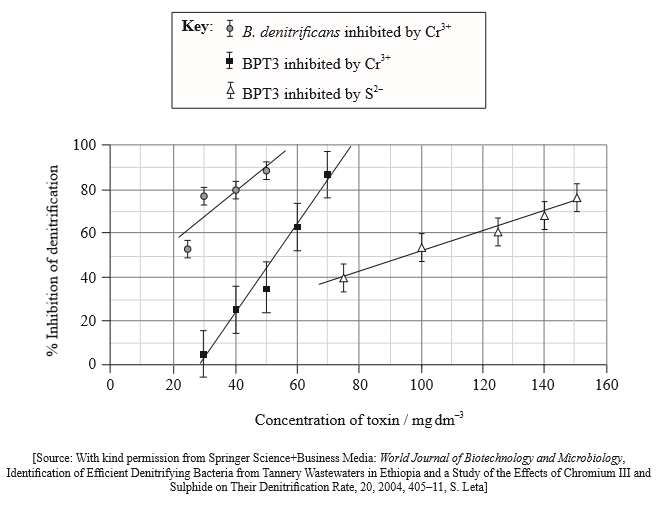
Predict the Cr3+ concentration that would cause 50% inhibition in BPT3.
Waste water from some industrial processes contains high levels of Cr3+. State, with a reason, which of the bacteria investigated should be used to treat this water.
Compare the effect of Cr3+ and S2– on the inhibition of BPT3.
Raw sewage contains high level of nitrates. Explain the importance of denitrification of raw sewage by bacteria such as B. denitrificans and BPT3 before it is released into rivers.
Answer/Explanation
Markscheme
53 mg dm–3
Accept answers in the range 51 to 54 (units required).
BPT3 because it is less inhibited by Cr3+
a. Cr3+ more toxic than S2– (between concentrations of about 67/70 and 80 mgdm–3);
b. Cr3+ toxicity increases more rapidly with increasing concentration than S2–;
c. Cr3+ requires lower concentration to cause same percentage inhibition (between 40 and 70%) as S2– / vice versa;
d. below (about) 30 (mgdm–3) Cr3+ not toxic whereas S2– effect not known/may be toxic / Cr3+ cannot be compared with S2– below concentration of 70/67 (mgdm–3);
a. denitrifying bacteria convert nitrate to nitrogen/N2;
b. nitrate causes eutrophication/algal blooms in rivers / removing nitrate reduces the risk of eutrophication/prevents algal blooms;
c. high levels of nitrate/algal blooms lead to anoxic conditions / increase BOD / reduces oxygen levels;
d. nitrate is toxic for humans (in high concentrations);
e. removing nitrate reduces the risk of nitrate entering drinking water;
Question
Explain how bacteria are used in bioremediation of soil.
Answer/Explanation
Markscheme
a. bioremediation uses bacteria to remove contamination;
b. suitable bacteria may already be present in the environment;
c. bacteria may use contaminants in metabolism/as an energy source;
d. end products (of metabolism) are less toxic than (inorganic) contaminants;
e. bacteria may concentrate/isolate it within the microbial cells;
f. can be carried out in situ or ex situ;
g. suitable example (eg degradation of solvents / oil spill cleanup / oxidation of selenium / can be used to deal with pesticides);
h. second suitable example;
i. useful bacterial strains obtained by genetic modification;
Question
Outline the diversity of Eubacteria according to cell wall structure.
State the role of Rhizobium and Nitrobacter in the nitrogen cycle.
Rhizobium: …………………………………………………..
Nitrobacter: …………………………………………………..
Explain the use of bacteria in bioremediation.
Answer/Explanation
Markscheme
can be Gram-positive or Gram-negative;
Gram-negative have a thinner wall/less peptidoglycan/converse;
Gram-negative have an outer layer of lipopolysaccharide and protein;
Rhizobium: converts atmospheric nitrogen to ammonia / nitrogen fixation;
Nitrobacter: oxidizes nitrite into nitrate / nitrification;
bacteria remove contaminants from the environment;
by using them as energy sources;
(or) by converting them to a soluble/ harmless form;
example of bioremediation (e.g. Pseudomonas is used to clean up oil spills);
Question
The diagram below represents the cell walls of two different bacteria. State, with a reason, which cell wall (I or II) is Gram-positive.

Microorganisms play many roles in ecosystems. List two of these roles.
1. …………………………………………………………
2. …………………………………………………………
Answer/Explanation
Markscheme
I (is Gram-positive) because it has thick/outer layer of peptidoglycan/does not have outer layer (of lipids) external to peptidoglycan layer
producers / food source in aquatic environments;
nitrogen fixers / denitrifiers;
decomposers;
methane producers;
Question
State, giving one specific example, how individual bacteria change their characteristics when they form aggregates.
Answer/Explanation
Markscheme
example;
change;
e.g.:
Vibrio fischeri;
emit light when part of high density population/high concentration of regulatory substance;
Accept other verifiable example.
Question
Release of sewage in marine waters is a common practice but it can cause water contamination with pathogens. A series of experiments were conducted to compare inactivation rates of two different groups of microbes with different sunlight exposures. One group were fecal coliform bacteria and the other were coliphage viruses. Experiments were conducted outdoors using 300-litre mixtures of sewage-seawater in open-top tanks.
A two-day experiment was carried out with untreated sewage added to seawater. Both days were sunny with no clouds. The figure below shows the inactivation of the microbes in seawater as a function of the cumulative amount of sunlight and time. The survival curves of the two microbes are plotted against sunlight exposure (lower x axis) during daylight periods and against time during the overnight period (upper x axis). The y axis gives counts of bacteria and viruses per 100 ml.
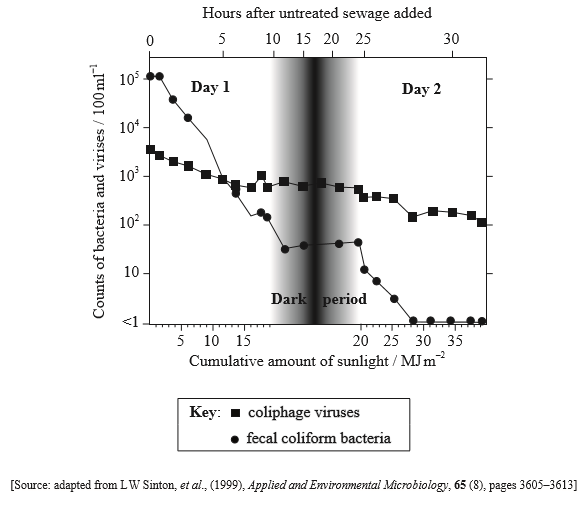
Identify the time at which fecal coliform bacteria counts fell below 1 unit per 100 ml.
Deduce, using the data in the graph, the effect of sunlight on fecal coliform bacteria.
Deduce, using the data in the graph, the effect of sunlight on coliphage viruses.
For an accidental sewage spill, suggest, giving a reason, which of the two microbes may be most useful as a fecal indicator two days after the spill.
Answer/Explanation
Markscheme
28 hours after untreated sewage added (Allow answers in range 27–29 hours)
sunlight reduces counts of fecal coliform bacteria significantly;
fecal coliform bacteria fall below 1 count per 100 ml on day 2;
no reduction during dark period;
significant drop on day 1 / bacteria count drops from 105 per 100 ml to less than 102 per 100 ml on day 1;
sunlight causes small reduction of coliphage viruses;
coliphage virus counts never fall below 102 counts per 100 ml;
no reduction during dark period;
coliphage viruses because they are less affected by the sun / numbers do not decrease much in two days
Question
Removal of toxic heavy metals from industrial waste water is essential in order to control environmental pollution. Industrial waste water near Yanbu City, Saudi Arabia was found to contain 19 species of microorganisms that could tolerate heavy metals. The accumulation of cadmium ions in the most common of these microorganisms, Aspergillus fumigatus, was investigated.
The graph below shows the effect of pH on the ability of A. fumigatus to absorb cadmium ions from an aqueous solution.
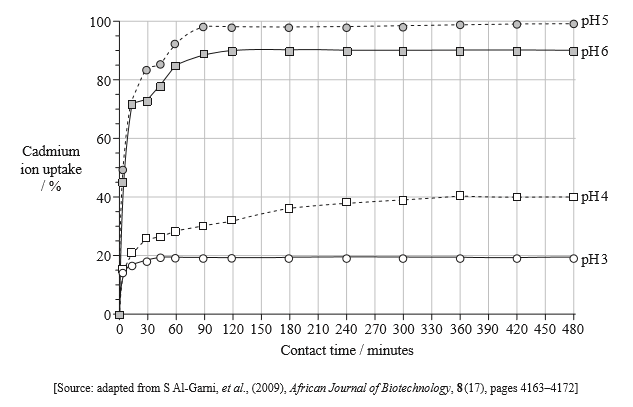
Describe the cadmium ion uptake by A. fumigatus at pH 6.
Calculate the difference in cadmium ion uptake between pH 4 and pH 5 at 60 minutes.
……………………..%
Discuss the use of A. fumigatus for the removal of cadmium ions in polluted waters.
The investigation found that both living and dead A. fumigatus cells were able to absorb cadmium ions. Suggest an advantage of using dead A. fumigatus cells.
Answer/Explanation
Markscheme
rapid initial uptake (to approximately 75 % uptake);
rate of uptake slows and plateaus (at approximately 85 % uptake after 90 minutes);
only 90 % of cadmium ions absorbed (however long the contact time) / reaches maximum at 120 min;
64 (%) (allow responses in the range of 62 to 66 %)
can remove almost 100 %/98 % cadmium ions at pH 5 therefore very efficient;
A. fumigatus able to remove cadmium ions at pH values tested;
removal of cadmium ions more efficient at higher pH/weak acid;
strongly acidic/very low pH may inhibit/reduce uptake of cadmium ions by A. fumigatus;
pollution causing acidification of water may make removal more difficult;
A. fumigatus common therefore may be convenient/easy to use / OWTTE;
cadmium is not actually removed as it may pass along food chains / be released when A. fumigatus dies / unknown impact on environment;
easier to store/collect/transport dead/dried material;
prevents overgrowth of A. fumigatus;
reduce BOD and allow other organisms to use more resources/live in water;
Question
Explain the use of bacteria in the bioremediation of water.
Answer/Explanation
Markscheme
a. example of where this has been used e.g. Exxon Valdez spill, Alaska / other correct example;
b. indigenous/existing bacteria can break down oil;
c. bioremediation is the use of nutrients to enhance the activity of existing organisms / the addition of non-indigenous microorganisms;
d. converts the toxic compounds of oil to non-toxic products;
e. bioremediation is used after other cleanup methods have been used;
f. bioaugmentation is when bacteria are added to supplement the existing microbial population;
g. biostimulation is when nutrients are added to stimulate the growth of the existing oil-degrading bacteria;
h. bacteria added seem to compete poorly with the indigenous population;
i. nutrient concentrations have to be sufficient to support the maximal growth rate of the bacteria throughout the clean-up operation;